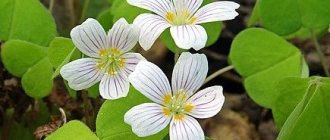Oxalis, Oxalis, oxalis, "lucky clover" are annuals and perennials, some of which form tubers. The genus includes about 800 species of herbaceous perennials and shrubs, distributed throughout the globe. All oxalis are low plants, 8-10 cm high, densely covered with small trifoliate or pinnately compound leaves. The peculiarity of sorrel is its “exploding” fruits, which shoot out small seeds when ripe.
- Wild species of wood sorrel Common wood sorrel, hare cabbage and sour clover, cuckoo clover / Oxalis acetosella
- Carob sorrel, horned sorrel or yellow sorrel, northern sorrel / Oxalis corniculata, syn. Xanthoxalis corniculata
- Oxalis triangularis, Oxalis regnellii Purple trefoil or False Trefoil / Oxalis triangularis, Oxalis regnellii
- Oxalis tuberosa / Oxalis tuberosa
Etymology of the name OHALIS
The genus name reflects the sour taste of the plant (oxys translates as “spicy”). Common sorrel (Oxalis acetosella) is commonly known as hare cabbage or sorrel, in Germany this plant is known as “sour clover”.
Wild wood sorrel
Common sorrel, hare cabbage and sour clover, cuckoo clover / Oxalis acetosella
Common oxalis is a Eurasian species that grows very widely in nature: throughout Europe, the Caucasus, Turkey, China, Mongolia, and North America.
Common oxalis blooms in the forest in May.
Common sorrel is a perennial spring-flowering plant, only 5-10 cm high, with a thin creeping rhizome. The leaves are slightly pubescent above, trifoliate, on long petioles, the leaf petioles are reddish. The flowers are white, bisexual, regular and simple with a yellow spot in the center. Blooms in May.
Use of wood sorrel in cooking
The leaves contain oxalic acid. Common oxalis has a slight sour taste, BUT in large quantities it can cause irritation to the kidneys and urinary tract.
Leaves ground with sugar are used to prepare a vitamin drink.
Fresh leaves are used in salads, as a seasoning for egg dishes and soups.
Be careful: long-term use of this plant can lead to kidney disease!
The use of wood sorrel in ornamental gardening
Used in large parks and gardens to create a beautiful spring ground cover. Common oxalis reproduces well by seeds and by dividing the bush.
Types and varieties of oxalis suitable for growing in the garden
The genus includes more than 400 species, distributed in South America, Europe and Africa.
Carob sorrel, horned sorrel or yellow sorrel, northern sorrel / Oxalis corniculata, syn. Xanthoxalis corniculata
A perennial plant, it forms a thicket 20-25 cm high. The stems are thin, numerous, the leaves are trifoliate, petiolate.
Blooms in May-June with small yellow flowers. Most often, after planting, it begins to grow weeds throughout the entire area, drowning out other brothers in the flower garden.
Just like wood sorrel, it has a slightly sour taste and is edible in small quantities.
The garden form with brown-red leaves var. has the greatest decorative value. Purpurea. Can be used for planting in containers.
Oxalis adenophylla
Another winter-hardy species of sorrel. USDA Zone 4
A perennial plant, no more than 7 cm high, blooms in spring with pink flowers. The ferruginous sorrel has very beautiful leaves: they consist of many lobes (10-22), silvery. There are varieties with spots or veins.
Growing ferruginous oxalis
Ferruginous oxalis loves bright, but not direct sunlight. Does not like getting soaked, naturally grows in dry places. For the winter, it is advisable to mulch and hill up.
It can be grown at home, on window sills or balconies, but it still grows better in the garden. When growing indoors for the winter, it is advisable to put the pot in the refrigerator (basement, balcony) and water it carefully, along the edge of the pot. Also for the winter, like many container crops, you can dig it directly with the container in the garden and cover it with mulch or lutrasil on top.
Ferruginous oxalis when planted in the ground.
White sorrel / Oxalis lactaea
The perennial plant is a low-growing plant with dark, brownish-green, trifoliate leaves. Blooms with white flowers. It grows well.
Oxalis poor / Oxalis inops
Perennial corm plant, quite frost-resistant.
The leaves are trifoliate on thin petioles. The flowers are dark pink with a white center. Blooms in August-October.
Depp's Oxalis / Oxalis deppei
Corm perennial plant 25-35 cm tall, with four-part leaves 3-4 cm long, green with a purple-red pattern.
The flowers are crimson-red, 2 cm long, collected in an umbrella-shaped inflorescence.
Depp's oxalis is suitable for growing in the garden as a lenika or for container growing, as well as indoors.
Depp's Oxalis when grown as an annual plant in the garden.
Growing Depp's oxalis indoors
In winter they are kept in cool conditions. Tolerates dry room conditions well.
Rose sorrel / Oxalis rosea
Height 30-35 cm. Blooms with pink flowers.
Oxalis enneaphylla / Oxalis enneaphylla
A perennial plant 5-10 cm high, forming small clumps. It is beautiful, but in a culture in our region there may be problems when growing it. It blooms in May-June with white or pink flowers.
Oxalis nine-leaved
Growing nine-leaved wood sorrel
Planting requires acidic, humus-rich soil, good drainage and sun. For the winter, dry shelter is necessary.
Caring for oxalis in the garden
The main difficulty in caring for frost-resistant wood sorrel is to prevent them from growing uncontrollably. Ripe fruits of plants crack, throwing seeds over considerable distances, so you should not plant sorrel near vegetable beds.
Types and varieties of oxalis suitable for growing indoors
Oxalis triangularis, Oxalis regnellii Purple trefoil or False Trefoil / Oxalis triangularis, Oxalis regnellii
Oxalis triangularis is the trade name of the species, in the scientific literature it is more often found under the name Oxalis regnellii
A rhizomatous plant with large dark purple leaves with a darker border around the edge. Height 15-30 cm. Flowers white or light pink.
The plant propagates easily using rhizomes.
Varieties of triangular sorrel
Oxalis triangularis subspecies papilionacea has green leaves and white flowers.
The Irish Mist variety is a variety with green spotted leaves and white flowers.
Conditions for keeping triangular sorrel
A plant with a pronounced dormant period: it sheds its leaves in winter. From October to February, the plant is kept at a temperature of +5...+10 and with minimal watering. In the summer it is useful to take it out into the garden or onto the balcony.
Caring for triangular sorrel.
The species reproduces well by dividing the bush; in indoor conditions it rarely produces seeds.
Oxalis bowiei
Herbaceous corm, heat-loving perennial with small light green leaves on long petioles. Blooms in summer with dark pink flowers.
Oxalis Bovey.
Purple sour / Oxalis purpurea, Oxalis variabilis
A thermophilic species, it grows naturally in South Africa.
A perennial corm plant with round, trifoliate leaves and large flowers, up to 2 cm in height, of various colors: they can be from white to pink or purple-red.
Purple oxalis with large purple flowers and bright beard-colored leaves.
In many heat-loving countries where purple sorrel grows in the ground, it is a weed, for example, in South Australia.
Flowering varietal sorrel purpurea.
Many types of wood sorrel are grown in hanging pots as hanging plants. Used for winter gardens or balcony flower beds. In the summer, even heat-loving species of wood sorrel can be planted in the garden.
Red sorrel / Oxalis rubra
Sometimes this species is classified as Oxalis articulata Savigny, or considered as a subspecies - Oxalis articulata subsp. rubra.
Red sorrel is a perennial southern (native to Argentina, Brazil and Uruguay) plant with thin green leaves and pink-purple flowers.
Oxalis jointed
Oxalis ortgiasii
A popular species in indoor floriculture.
A species with brown-red trifoliate leaves with deep notches.
The flowers are small, yellow.
Oxalis Obtusa
Miniature corm perennial plant, 10-15 cm high.
Oxalis Obtusa is a plant with many advantages:
- low maintenance;
- blooms profusely;
- the flowers are large and bright, a large number of decorative varieties have been bred;
- There are even aromatic varieties.
Obtus oxalis varieties:
- Ceres Salmon is a variety with orange flowers with a yellow center;
- Moonlight - a variety with lemon flowers with an orange halo inside;
- Nova is a variety with pink flowers with a yellow center and a characteristic darker pink halo;
- Carol - variety with striped pink flowers;
- Large Form Dark - variety with large lilac flowers;
- Apricot Cream is a variety with peach-colored flowers and a rather bright halo.
Oxalis Obtusa
Varieties with a yellow center and a transitional halo to the main center.
Volcanic sour / Oxalis vulcanicola
A plant native to Central America. It grows well in a wide variety and grows well in a container. Suitable for growing indoors and in the garden, in container culture.
Volcanic oxalis bloom with small yellow flowers; their main advantage is their beautifully colored decorative leaves; the degree of decorativeness greatly depends on the lighting.
Features of growing volcanic sorrel
The dormant period of volcanic sorrel is weakly expressed. Loves coolness and diffused light. It is growing well. Watering is required moderately, without drying out. The soil is light, nutritious, with drainage. Good for pruning.
Interesting varieties of volcanic oxalis:
Molten Lava, Sunset Velvet, Burgundy, Plum Crazy, Molten Lava.
Volcanic wood sorrel variety Molten Lava (Molten Lava).
Caring for oxalis indoors
Oxalis are generally light-loving plants, but require shading during hot midday hours.
Oxalis grow well in cool rooms. In winter, during the dormant period, they are kept at a temperature of +12…+14 °C. Ortgis oxalis requires a temperature of +16…+18 °C in winter.
Deppe's oxalis loses its leaves in winter, and during this time the pot with the bulbs is placed in a cool place (+8...+10 °C). In spring, the bulbs are transplanted into fresh soil mixture. Water very rarely until leaves form.
For all other species, watering is plentiful, which is reduced to moderate in the fall.
Oxalis when grown indoors.
During the growing season, oxalis are fed weekly with a weak solution of complete mineral fertilizer. Replant in the spring every couple of years. For planting, use a soil mixture of peat, leaf soil, humus and sand (3:1:1:1).
Oxalis is rarely damaged by diseases and pests.
Place to grow a flower
In order for the plant to please its owners for many years, it should be given a bright place without direct sunlight , where it will be easy to maintain the same temperature throughout the entire growing period. In winter, around +10°C is considered optimal, in summer - +20°C. The best windows in an apartment for growing oxalis are considered to be eastern and western.
The location of a pot with a flower plant in a child’s room is considered very . It will support the immune system, fight infections, protect against ill-wishers, and in addition, it will help the child cope better with homework. He will discover special abilities and talents.
Oxalis hedysariformes.
definitely put oxalis in the bedroom . During the day, it will generate positive energy, and so that it does not absorb it back at night, it can be moved away from the bed.
Edible species of sorrel
Oxalis tuberosa / Oxalis tuberosa
Oxalis tubers contain a lot of starch - up to 25%. The color of the tubers is white, yellow, pink, bright red and purple.
The tuberous sorrel is not found in the wild. And it is impossible to propagate it by seeds - the flowers are sterile. It is bred exclusively using tubers.
Read more about growing tuberous oxalis in our material>>>
Tubers of tuber oxalis.
Why is oxalis needed in the house: signs
Oxalis is not only possible, but also necessary to be kept at home. In this case, the damaged relationship between parents and children is quickly restored .
For people who lead an active lifestyle and spend a lot of energy, the plant will help them recover faster and prevent depressed mood and apathy.
Oxalis Cupido.
Reproduction of wood oxalis
Propagated by daughter bulbs (Oxalis deppei), or by dividing the bush and cuttings. It all depends directly on the type of sorrel itself.
Plants are usually transplanted and divided after 2-4 years. The distance between plants in the garden is usually 20-30 cm when planting.
Some species grow weeds and it is quite difficult to stop their uncontrolled reproduction.
Who needs this gift?
It’s good to give oxalis to a lonely person . He will definitely meet a faithful and devoted soul mate.
Oxalis Nineleaf.
Give this plant to someone who is experiencing problems in life . You will see how his life will change. Good luck will come to the person, his affairs will change dramatically for the better.
More interesting rare species and varieties of wood sorrel with photos
Oxalis Imbricata
Oxalis corymbosa
Oxalis latifolia Maroon Leaf
Oxalis melanosticta
Goat sorrel / Oxalis pes-caprae is a perennial herb native to South Africa. It is now a noxious weed in the United States (particularly coastal California), Europe and Australia. Used as a source of oxalic acid, as food and in folk medicine.
How to protect yourself from signs?
Only positive qualities are used for sorrel. This is well-being, prosperity and love in the family, mutual excellent relationships between generations of relatives . But it also happens that the plant begins to wither. In this case, you should look after him more carefully and say a few kind words.
Oxalis flower helps families with many issues. You should be near him as often as possible, and then troubles, misfortunes, depression and troubles will avoid you. Love, prosperity, friendliness and happiness will settle in the house.
Subscribe to our Social networks











